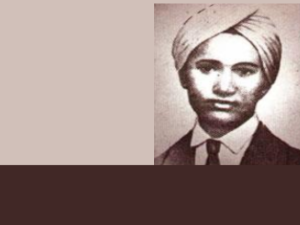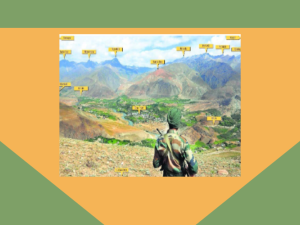Eminent Grewal Personalities of Gadar Movement-4
GYANI NAHAR SINGH GREWAL GUJJARWAL
Gyani Nahar Singh Gujjarwal s/o Sardar Thakur Singh was born in 1892 AD. He got his primary education at a village primary school and high school education at Malwa Khalsa High School Ludhiana. He started a Youth Association in the school and remained its secretary. Hr used this association for propagating Sikhism and for independence from the British. He regularly attended Gurdwara functions daily as well. He keenly studied the lives of the freedom fighters. He got attached to Sardar Kartar Singh Sarabha and became a part of his Gadar movement. Due to the seditious activities of Gadarites, he was given 10 years imprisonment in the second Lahore Conspiracy case on 30th March 1916. He was released from jail after 5 years. Thereafter, he started working for the Akali Movement with full zeal, dedication, and commitment. He started the paper 'Asli Kaumi Dard' under his editorship for propagating freedom with the help of NRIs who sent money for running the paper. This paper was published in a number of years. He was later the editor of 'Dusht Daman', 'Gur Sewak', 'Panjabi Ratan, and 'Khalsa Advocate papers. He also edited and published over a dozen books by Bhai Sahib Bhai Randhir Singh. After independence, his book 'Panjab dian Lehran' was honoured by the Punjab government with an award of Rs 1100/-. He passed Gyani and OT from Khalsa College Amritsar and served in District Board Ludhiana for some months. He was very keen in teaching. In 1944, he started teaching at Khalsa High School Gurusar Sudhar. He worked with great interest and was very much liked by the students and the staff. He passed his BA at the age of 63 years. Gyani Nahar Singh was a top-class news editor and well-known writer who wrote till the end of his life. His interests included the fight for freedom, struggle for the people, religious service, and education. His son Mrigind Singh Grewal was a Wing Commander in Air Force who died young in an air crash (43).
Eminent Grewal Personalities of Gadar Movement-5
SAJJAN SINGH GREWAL NARANGWAL
Sajjan Singh was a close associate of Kartar Singh Sarabha and a leading figure of Bhai Randhir Singh Jatha. He was born to S. Miha Singh and Mai Inder Kaur of Narangwal Ludhiana. His association with Kartar Singh Sarabha started from the days of their schooling at Malwa Khalsa High School, Ludhiana. Being active in the freedom movement, he was also arrested in the second conspiracy case of Lahore. At the time of judgment, the judge wrote in his orders, "From the statements of the witnesses, it appears that Sajjan Singh is more dangerous than Kartar Singh Sarabha. If he would not have been of such a young age, I would have given him the death punishment." He was given the punishment to be imprisoned in Andamans on 30 March 1916 under sec 121. All his property was also confiscated. When he was being shifted from Central Jail Rawalpindi to Andamans, at Hazari Bag he planned to run away by breaking the jail. This is a different story. When he was released after long imprisonment, his spirit for independence was still very high. After his release from imprisonment, he served Khalsa High School Mehma Singh Wala as Punjabi Teacher. Such a dedicated and committed freedom fighter is an asset to any nation. (48).
Eminent Grewal Personalities of Gadar Movement-6
GADRI BABA GURMUKH SINGH LALTON KALAN
Gurmukh Singh Lalton was one of the great Freedom Fighters of the 20th century. As a simple village youth, with a meager amount, he left home in Lalton Kalan in 1913 to seek fortune in foreign lands. He landed in Hong Kong to proceed to Canada. He met Gurdit Singh (Komagata Maru) and joined the desperate travelers. On May 23, 1913, they were refused to land at the Vancouver port. The ship turned back to the Bay of Bengal to drop these persons at the Baj-Baj ghat instead of Calcutta docks. Gurmukh Singh and others were fired upon. He was arrested, and taken to the Alipur jail. Undergoing mishaps and hard times, he kept his spirits high. He returned to Punjab. By this time he had tasted the bitter side of racialism, colonialism, etc. (45)
He turned his anger into rebellion. Kartar Singh Sarabha, Nidhan Singh Chugga, Uttam Singh Hans, and Arjan Singh Jagraon planned to work to bring about a revolution for freedom. They hoped that the Indian army would help them in achieving their aim. His was a desperate move resulting in his involvement in the Lahore conspiracy case. Gurmukh Singh was arrested, tried, and sent to Andamans. He saw real hell during 1917-22. Sensing trouble, he was sent to Trichy. Later, on way to Wardha, he jumped in handcuffs from the train near Nagpur. He met C. Rajagopalachari in Madras, who looked indifferent and kept silent. Not discouraged, he went to Hazur Sahib and could stay hard for a week as he caused suspicion. Baba Nidhan Singh helped him with money and advised him to move to a safe place.
He returned to Punjab and stayed at Langeri village in Hoshiarpur district at the farmhouse of Bhai Piara Singh. He was a pious person who visited Afghanistan to preach the ideals of Sikhism. Teja Singh Swatantar who was already doing this work, accepted Gurmukh Singh to join him. Master Udham Singh Kasel also joined them. Between 1922-24, Baba Gurmukh Singh stayed there. Meanwhile, Santokh Singh was busy with his Punjabi paper Kirti and Ratan Singh Dabba with his hand-written press adventure. They had returned from Russia after getting training in spreading socialism. Gurmukh Singh was much impressed. He, too, wanted to leave for Russia, which he did. He had Baba Prithvi Singh (Lalru) with him. Gurmukh Singh was a daredevil; Prithvi Singh was cautious and cool. He moved around in Soviet Russia, met many revolutionaries, attended camps, etc. On an impulse, he left for America. It is surprising to learn how could a youth without many material means and devoid of professional training, could muster such courage! In California, he made contacts, reviewed the post-Gadar situation, raised funds, reorganized the broken chain, and enthused patriots.
The farm of Kishan Singh of Gahaur was the central place. Hazara Singh Janetpura, Puran Singh, Niranjan Singh Pandori, Surat Singh Chetanpur, and Hazara Singh Hamdam were of real help to him. The years from 1929 to 35 were the most turbulent for this Gadri Baba. He was arrested by the Federal government but patriotic activists got him released on bail. Later, he left for Europe. Moving through half of Europe, he reached Kenya on a fake passport. He came to India via West Asia. He watched the Karachi session of the AICC, met leaders, and was disappointed with the poor pace of movement. He returned disappointed but was not disheartened. He liked an anti-British Afghan King Oman Ullah, who was replaced by Nadir Khan. Nadir Khan got Baba arrested. Through common friends, his flight to Russia materialized. He visited several East-European countries and Soviet Republics. He met Oman Ullah in Rome. Ultimately finding favorable avenues, he staged a comeback to Lahore by long sea and land routes. Here he worked incognito for Lal Dora. Living as a rebel, he was playing with fire. He was arrested, tried, and sentenced to jail. He was moved from one jail to another till February 1946. Riots followed by Partition 1947, post-Independence bloodbath, and mass-uprooting disillusioned him. He remained underground from 1948 to 1952 but turned bitter. He activated the Kisan Sabha. He finally took to raising a memorial at Jalandhar: Desh Bhagat Yadgar which now reminds his great effort. (42)





